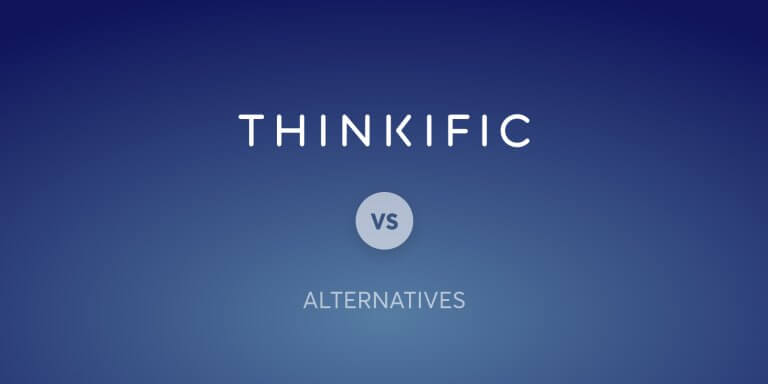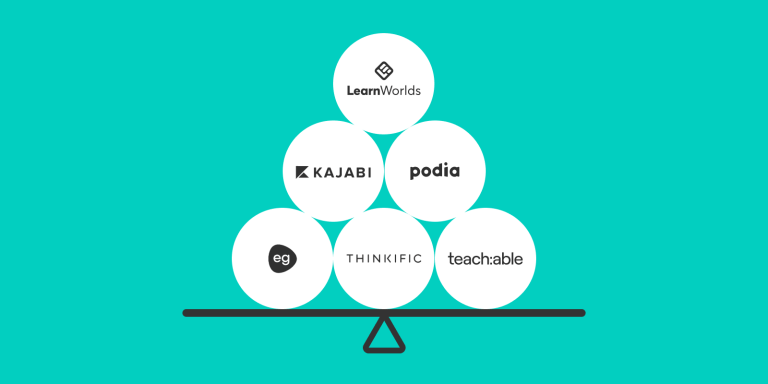Table of Contents
Thinkific is a popular platform for creators looking to launch online courses, training, or coaching programs. It offers robust features, including a modern course builder, an app marketplace, and sales and marketing tools.
However, some users may find its learning features, support, and customization options limited for growing e-learning businesses. Indeed, Thinkific lacks support for SCORM files, live chat support, extensive design customization, and full white labeling.
In this article, we’ll explore alternatives to Thinkific that cater to edupreneurs, SMEs, and training businesses seeking to sell online courses or provide corporate training.
Our top recommendation among these alternatives is LearnWorlds. You can experience our platform firsthand with a 30-day free trial to discover its offerings!
Now, let’s do a quick recap on Thinkific’s pricing, advantages, and disadvantages.
Thinkific offers four main pricing plans. Instead of a free trial, it comes with a free plan with various limitations on what you can do e.g., 1 admin, 1 course, 1 community, and 2 spaces for community.
Most entrepreneurs start with the Basic plan and move along as their business grows.
The above pricing describes Thinkific’s monthly subscription rates. Yearly pricing comes with 25% off the monthly price but is charged annually.
*Pricing information retrieved from Thinkific, April 2024.
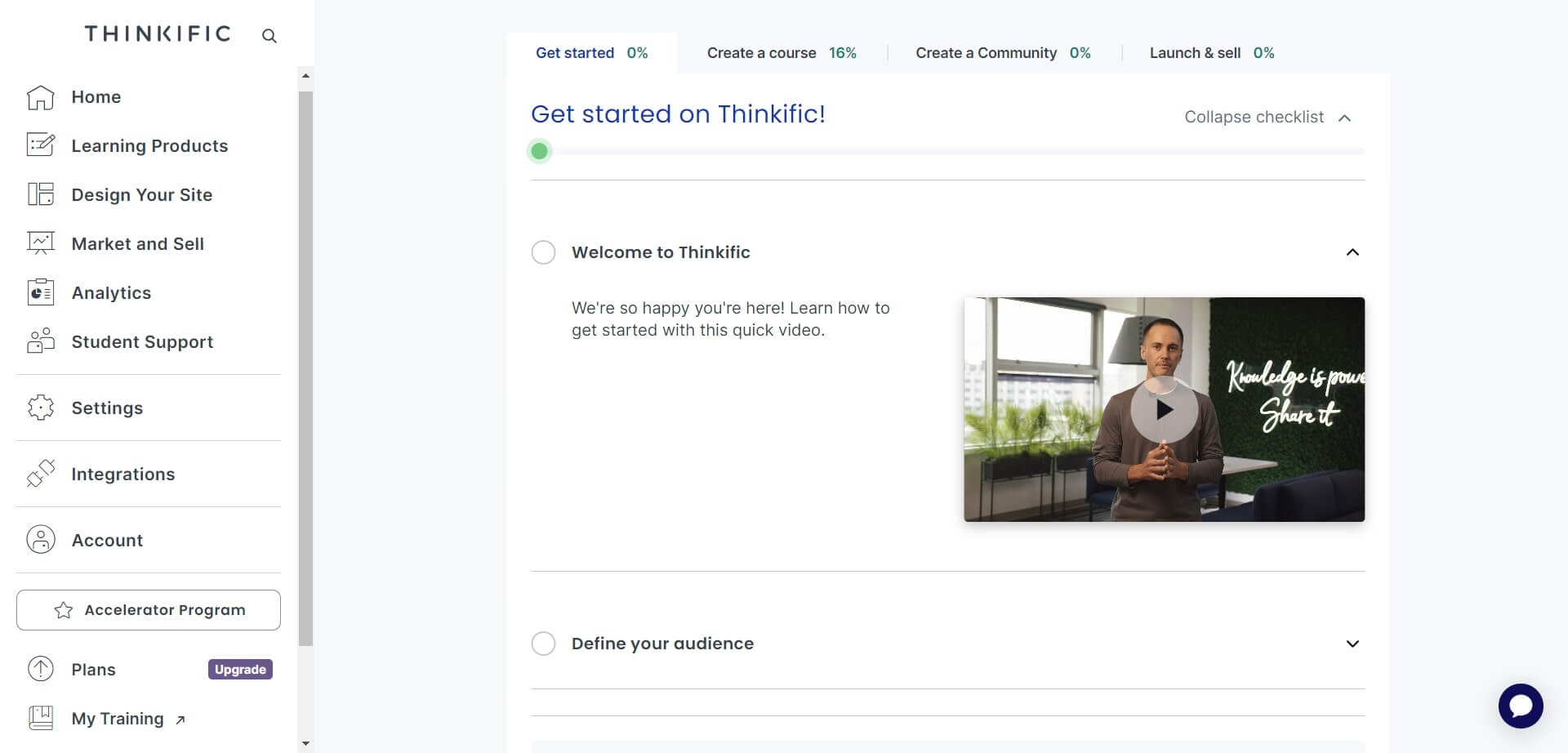
What are the pros and cons of Thinkific? Here, we’ll review its functionality, online course creation capabilities, and other key features.
Thinkific Advantages 👍
Thinkific is a great platform for anyone starting with online courses. It offers a user-friendly interface for building and managing online courses. It also provides a drag-and-drop website builder with templates and customizable design options.
The platform also comes with most marketing tools a creator needs to build subscriptions, sell and upsell courses, and deliver online training. If you can’t find something on Thinkific, they probably have an integration with another platform to do that.
Pros
- Free plan
- Supports multimedia lessons
- Easy online course creation
- Easy to use in general
- AI creator tools
- Drag & drop website builder
- Good customer support
- Mobile app for iOS & Android
- Sales & marketing features
- Lots of integrations & apps
Thinkific Disadvantages 👎
On the other hand, Thinkific lacks more advanced features that a growing e-learning business and professional course creators are looking for.
If scaling your business, reporting and advanced learning tools are essential. Hosting your business there may also seem limiting as you need to move from simple landing pages to full-scale websites.
Lastly, a pain point for many Thinkific users is the lack of a built-in email marketing tool which requires integration and has additional costs for setup.
Cons
- Limited learning & assessment tools
- Limited payment gateways
- Limited reporting & user management tools
- No interactive learning tools
- No SCORM, XAPI/TinCan, or AICC support
- No email marketing tool
- Limited live chat support
- Additional costs for integrations for features it does not have
- No real white-label option
Compare Thinkific with LearnWorlds
Compare Thinkific with Teachable
Compare Thinkific with Kajabi
Let’s move on to the top Thinkific alternatives for creating and selling an online course. We will be covering both all-in-one platforms, WordPress plugins, and LMS options.
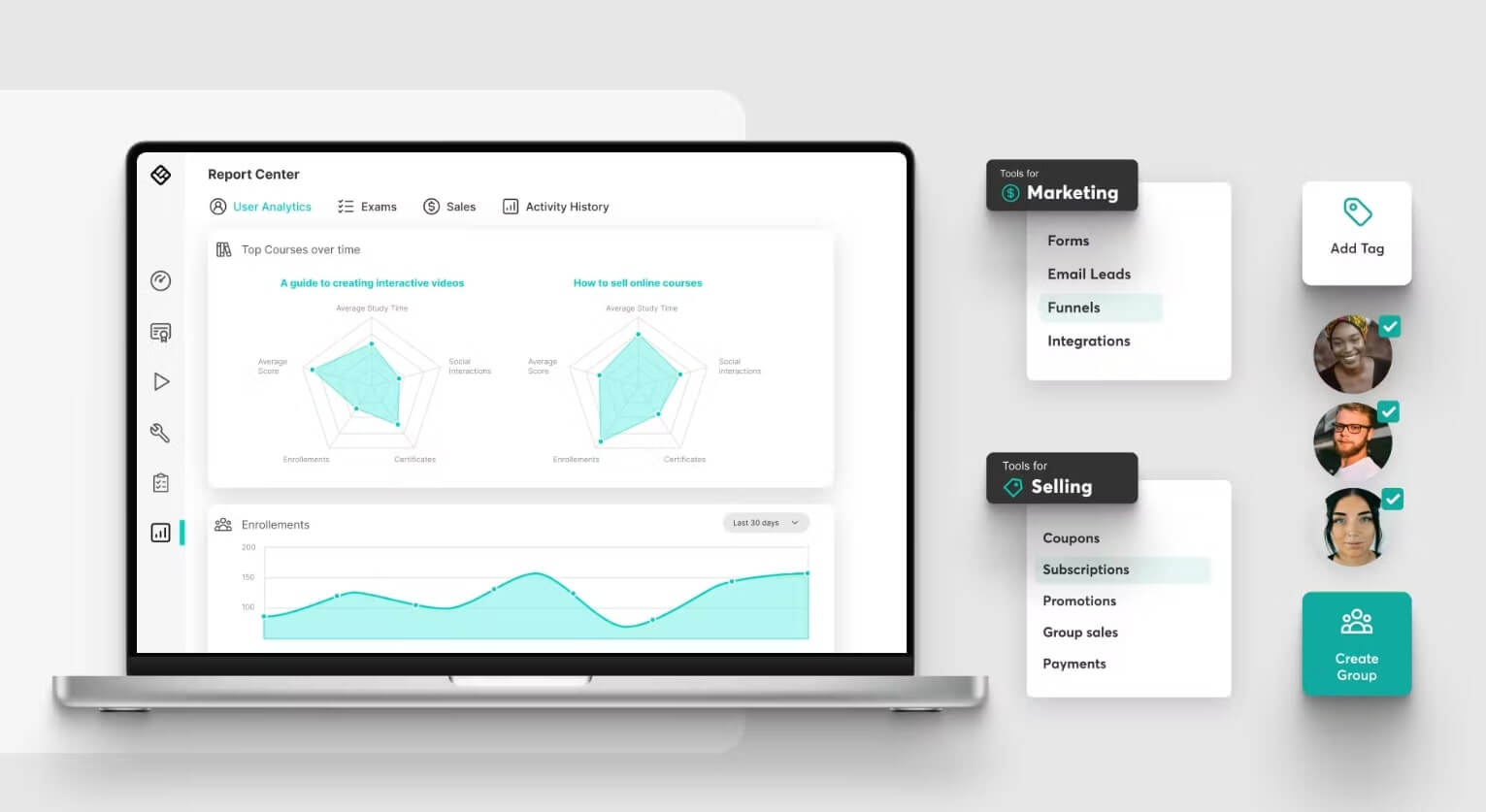
LearnWorlds is the best modern all-in-one online course platform for scaling your elearning business. It comes with the most impressive and advanced course-building features, a robust AI course creator, the most customizable site builder in the market, and some great marketing & sales tools to help you promote and sell your online courses.
LearnWorlds is most often compared as the closest platform to Thinkific. However, it offers many more e-learning and customization capabilities and provides a lot of unique features that you won’t find on Thinkific, such as:
With LearnWorlds, you can easily create and embed content adding many different learning activities to your courses. The content format it supports is extensive, ranging from text, PDF, audio, video, ebooks, SCORMs, and HTML5 packages, to Google Forms, Slideshare presentations, and live sessions.
But wait; we are getting ahead of ourselves. Let’s go through LearnWorlds’ pros and cons:
LearnWorlds has more advanced features on course authoring, allowing for more interactive learning experiences. Unlike other online course platforms, its capabilities go in-depth and enable you to offer quality education or training to your learners.
Pros
- Best-in-class course authoring tools
- Advanced assessments through a robust Assessment Builder
- AI-Course Creator
- Interactive Video Editor
- No-code Website Builder
- SCORM file support
- Native mobile app on iOS & Android (fully white-label)
White Label Academies
A notable exception is that many platforms promise white labeling but do not deliver. For example, Thinkific’s white labeling on the Grow plan only removes the Thinkific mention in the footer but still appears in the platform’s email notifications and code. You need to change to Thinkific Plus for email white-labeling, which comes with an even higher quoted price.
LearnWorlds, however, offers true white-label academies on its Learning Center plan and removes any mention of the brand, even from the code.
Cons
- There is a learning curve due to complex features
- No built-in email marketing
- No marketplace for courses
LearnWorlds offers a 30-day free trial and 3 main plans:
*Pricing information retrieved from LearnWorlds in April 2024.
LearnWorlds is a truly modern LMS platform that can make your online learning experiences stand out. Try it out with a 30-day free trial.
Find out LearnWorlds’ top competitors here.
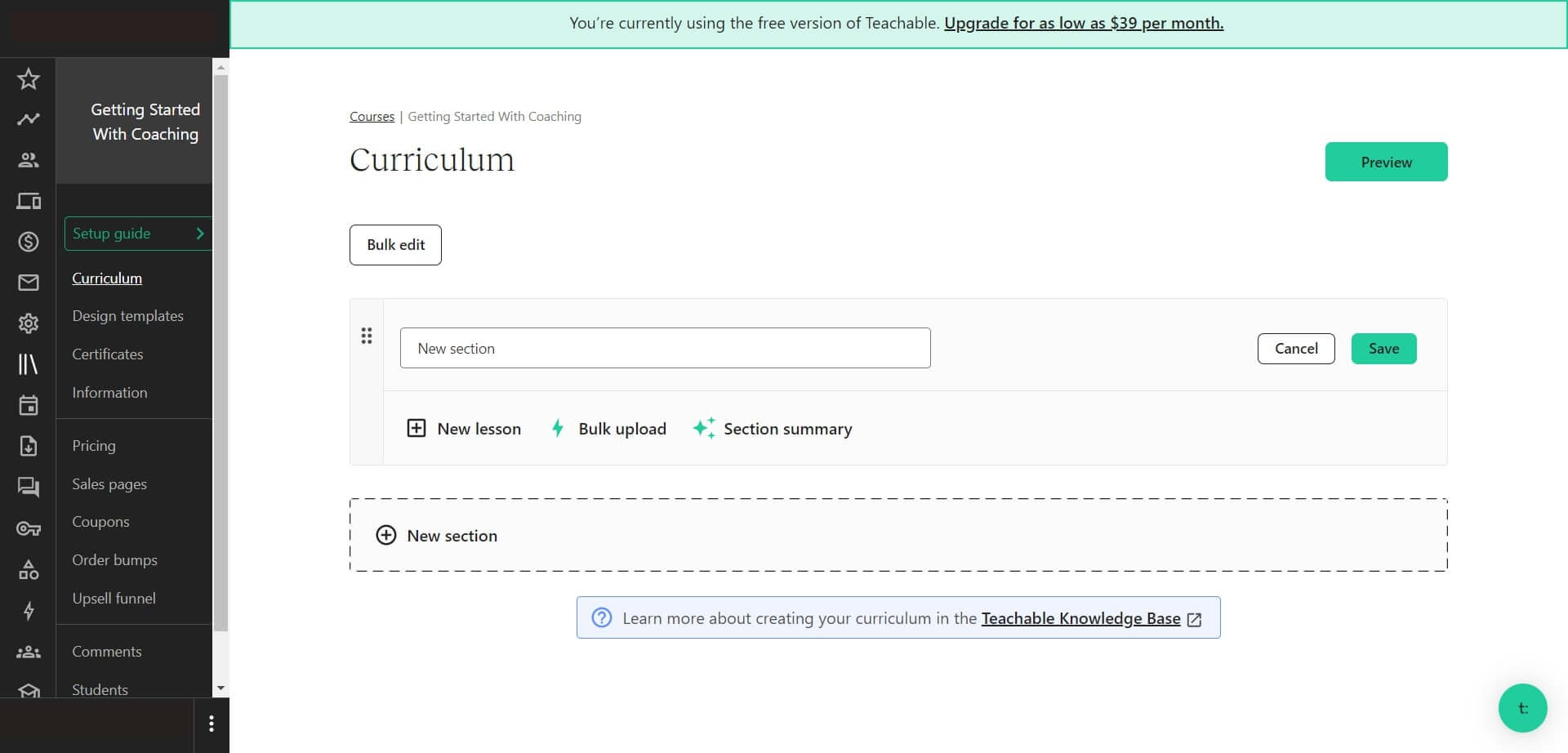
Teachable is a user-friendly standalone course platform with an intuitive design and tools for course management and student engagement. Its drag-and-drop functionality allows you to move things around and reorganize your content without fuss. While it’s a simple alternative to Thinkific, it lacks advanced course authoring capabilities, making it better suited for beginners.
The platform supports several file types, from text to pre-recorded videos and podcasts. It focuses more on marketing and integrates with many popular tools. Recently, Teachable has changed its focus to offer more support and features for online coaching over course creation.
Its biggest downside is that it can’t support growing businesses without having more advanced tools like white-label, course interactivity, or assessments.
Pros
- Free plan
- Intuitive user interface
- AI curriculum generator
- Thinkific communities
- Marketing tools (order bumps and affiliate program)
- Mobile App (not white-labeled)
Cons
- No white-label option
- No advanced learning & assessment tools
- No SCORM or XAPI/TinCan
- Poor customer support
How much does Teachable cost?
Teachable offers five plan tiers, some of which come with additional fees:
*Pricing information retrieved from Teachable, April 2024.
Compare Teachable with LearnWorlds
See Teachable’s competitors
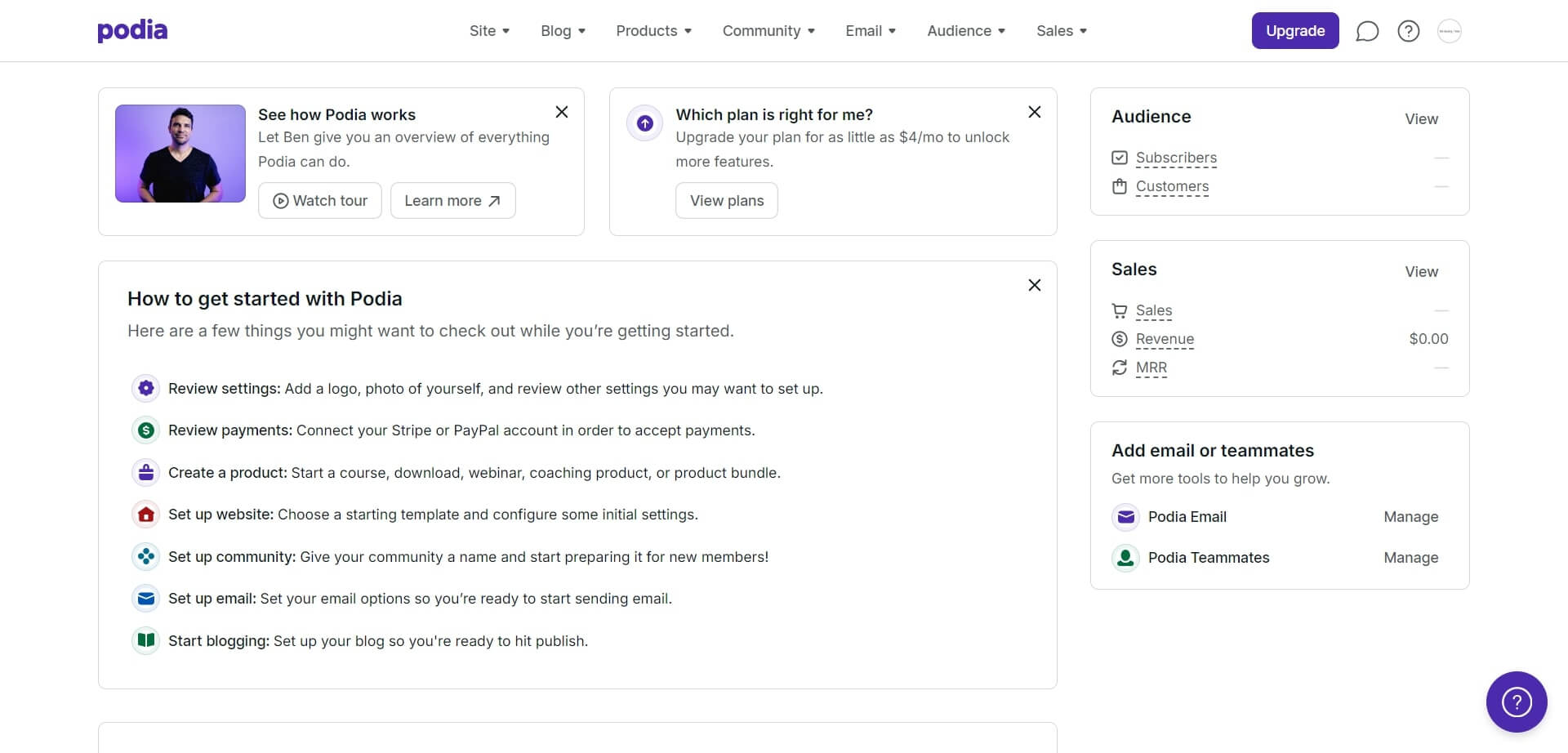
Podia is an all-in-one platform for selling digital products such as courses, memberships, and downloads. It is a cheaper clone of Kajabi and comes with very basic functionalities and features over what you will find in other Thinkific competitors.
Podia is great if you only want to sell simple digital products through digital marketing, but similarly to other course platforms, it also lacks advanced educational capabilities. Yes, it comes with all-around features an email marketing tool, and is considerably lower priced than other platforms.
But sometimes, a lower price comes with lower quality and fewer capabilities. Podia offers a free plan, which is great, but it is missing both educational and reporting features and does not provide possibilities for white-labeling. Also, if you want to scale your business, any form of advanced feature is missing.
Pros
- Free plan
- Relatively cheap
- Built-in email marketing tool
- Easy-to-use interface
- Discussions & community features
- Good customer service
Cons
- No white-label option
- No educational features
- No reporting or analytics
- No advanced features like SSO, API, Website builder, Automation, etc.
- Additional users come with an extra cost of $20
In short, Podia is suitable for anyone selling simple videos; downloadable and online courses are only another product they use to monetize their audience.
It’s great for cheap and quick courses but not for sustainable and growing businesses.
How much does Podia cost?
Podia offers a free plan and three paid plans. The plans have differences in transaction fees, the number of products you can create, and the support you are getting.
*Pricing information retrieved from Podia, April 2024.
Compare Podia with LearnWorlds
See Podia’s competitors
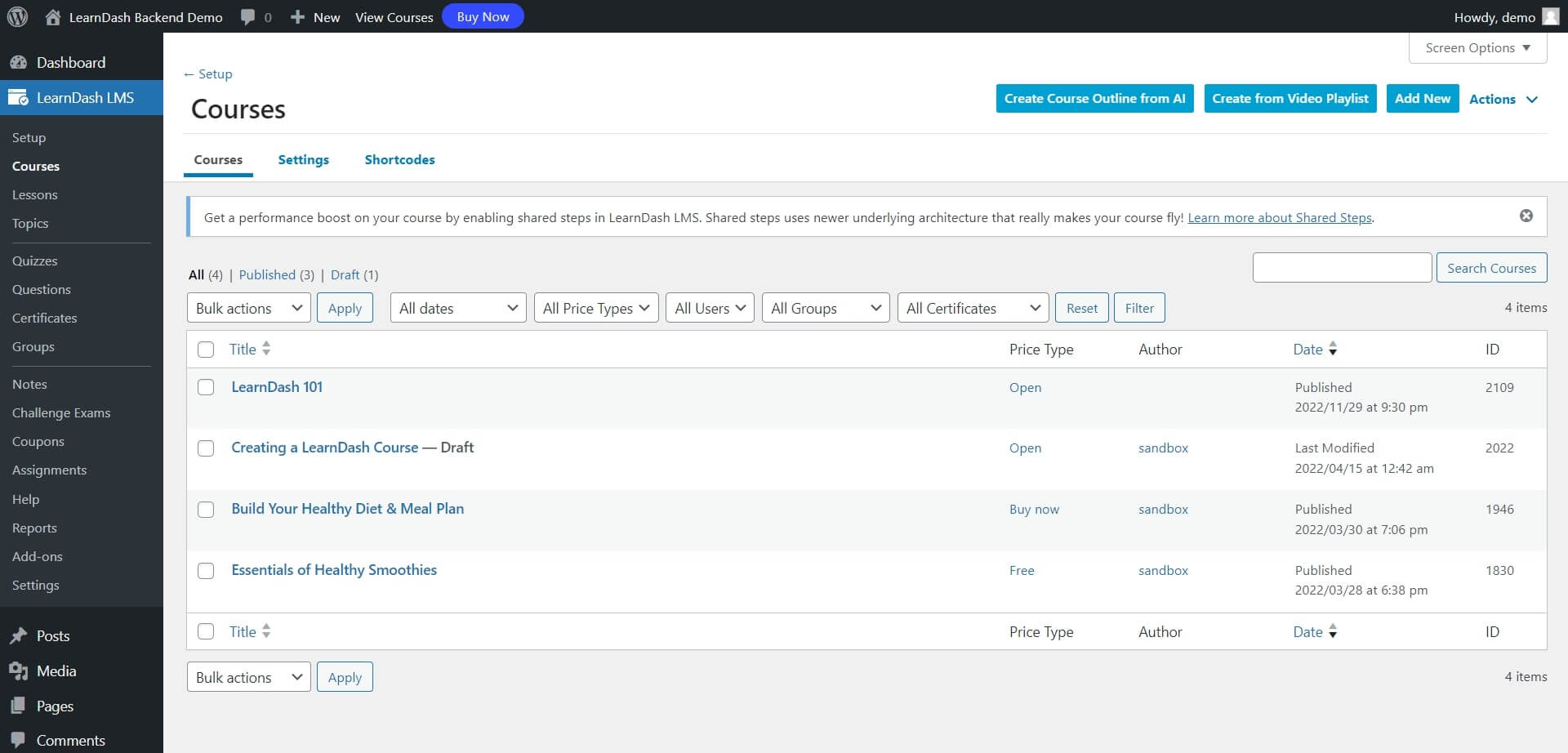
LearnDash is one of the top choices for WordPress LMS plugins that can help you create courses. WordPress plugins are preferred for their flexibility and customization for creators with a WordPress website. Even so, they require some technical knowledge to set up.
LearnDash is a far more affordable alternative to Thinkific than the other platforms on this list, but it comes with some hidden costs you need to be aware of. The platform is an excellent choice if you have experience with WordPress sites and the technical expertise to maintain them. A developer or web designer might be needed to help you implement the best results for your e-learning website.
Anyone who chooses LearnDash loves it for the price and customization, as they can combine it with other WordPress plugins to unlock more capabilities. However, because it is not a standalone solution, there is the need to pay and set up your server, include more plugins to receive payments, or have a community, and most of the additional features come as add-ons.
Pros
- Cheap for a course platform
- Simple and easy course authoring
- Integrates with BuddyPress, MemberPress, and WooCommerce
- White-label solution
- Customizable solution
Cons
- No free trial (only has a 15-day refund period)
- Hidden costs (for server hosting & maintenance)
- Requires other plugins to accept payments (it’s not a complete solution)
- Adding other plugins and add-ons can be expensive (e.g. for gamification)
- You need your own hosting provider and WordPress maintenance
How much does LearnDash cost?
LearnDash charges mostly yearly prices, and you can pay with a credit card or PayPal with a 15-day money-back guarantee. Each plan comes with several site licenses determining the number of websites you can use it for. These are the prices for the LearnDash LMS plugin:
If you prefer monthly plans, you can opt-in for LearnDash Cloud, which starts at $29/mo and includes the LMS plugin and ProPanel add-on.
*Pricing information retrieved from LearnDash, April 2024.
Compare LearnWorlds vs. LearnDash
See more LearnDash competitors
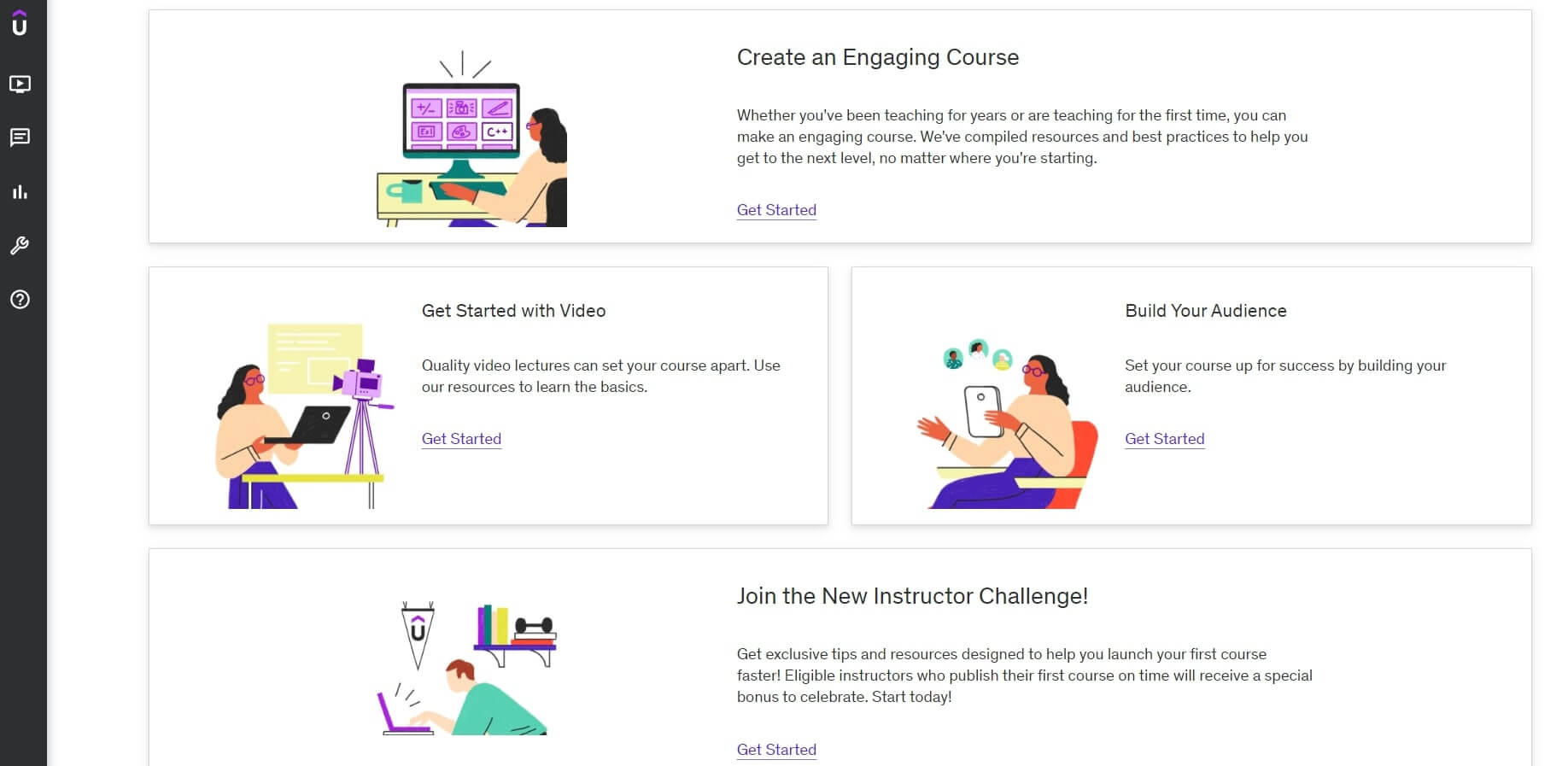
Udemy is one of the top marketplaces for online courses. The platform gives instructors a simple, straightforward way to assemble course content into a course experience. You can then publish your courses into a marketplace and use various marketing tools to promote them. While it seems that Udemy takes the marketing away, it’s not true. Due to the big competition there, you will still need to put in a lot of effort to promote your courses yourself before your course goes up in organic results.
Getting started with Udemy is easy and doesn’t require any technical knowledge. It’s ideal if all you want to do is teach and not get involved with the technical details of the process. Although Udemy is free, it can be challenging to maintain a full-time income with it because you don’t control your course’s pricing.
It doesn’t allow for white-labeling either, and you don’t own any of the data; this means you could be sending thousands of students to Udemy, only for it to push them toward a competing instructor.
Pros
- Easy to Use
- Free of charge
- No technical or design requirements
- Big audience looking for courses
- Helps with marketing the top courses
Cons
- Udemy takes a significant share of the profits
- It discounts the courses all the time (you can’t have premium courses)
- You do not own your students’ data
- You need to work on promoting yourself there
- There are many competitors next to your course
- There are instructor requirements and standards to follow
Udemy isn’t a course platform but a marketplace. You can use both Udemy and a hosted platform simultaneously, e.g. using Udemy to reach a larger audience for your courses and upsell the more expensive courses from elsewhere.
How much does Udemy cost?
You will hear that you can publish limitless courses with no budget. Udemy charges a significant fee for the sales! They call it instructor revenue share. An instructor can get 37% of the sale, while Udemy receives 63%, except if the instructor sells the course using a coupon or affiliate link.
*Pricing information retrieved from Udemy, April 2024.
Check out Udemy Alternatives here.
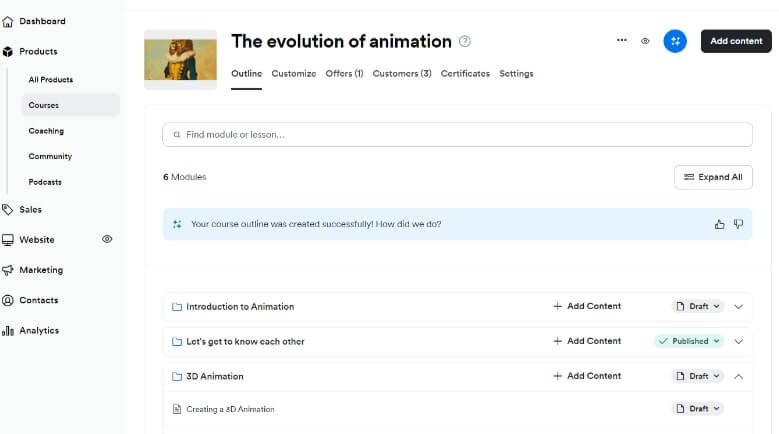
Kajabi is one of the most popular course platforms in the market. With Kajabi, you can host your online business with all the features you need for your website, course sales pages, course building, membership sites, email marketing, sales funnels, etc.
Compared to the other all-in-one online course platforms, Kajabi offers more in terms of marketing and less in learning management. Solopreneurs and SMEs prefer Kajabi as a one-stop solution only for the ability to send email blasts and offer automation to their users.
The platform is also a one-stop shop for creators to monetize their content, with all the authoring and marketing in one place. However, it is very pricey, especially for anyone starting out, and it doesn’t offer enough user management, reporting, and learning tools for scaling businesses.
Pros
- A complete solution to sell digital products
- Course authoring templates
- AI Creator Hub
- Marketing and email automation (funnels)
- Mobile apps for iOS and Android
- Good customer support
Cons
- Udemy takes a significant share of the profits
- Most expensive platform
- No free plan (only a 14-day trial)
- Lacking of advanced learning features
- Very basic website builder
How much does Kajabi cost?
Kajabi’s lowest plan starts higher than most platforms’ middle plan but offers more features in terms of marketing with limitations on the products, pipelines or funnels, admins, contacts, and active members.
*Pricing information retrieved from Kajabi, April 2024.
Compare Kajabi with LearnWorlds
Compare Thinkific with Kajabi
See more Kajabi Alternatives
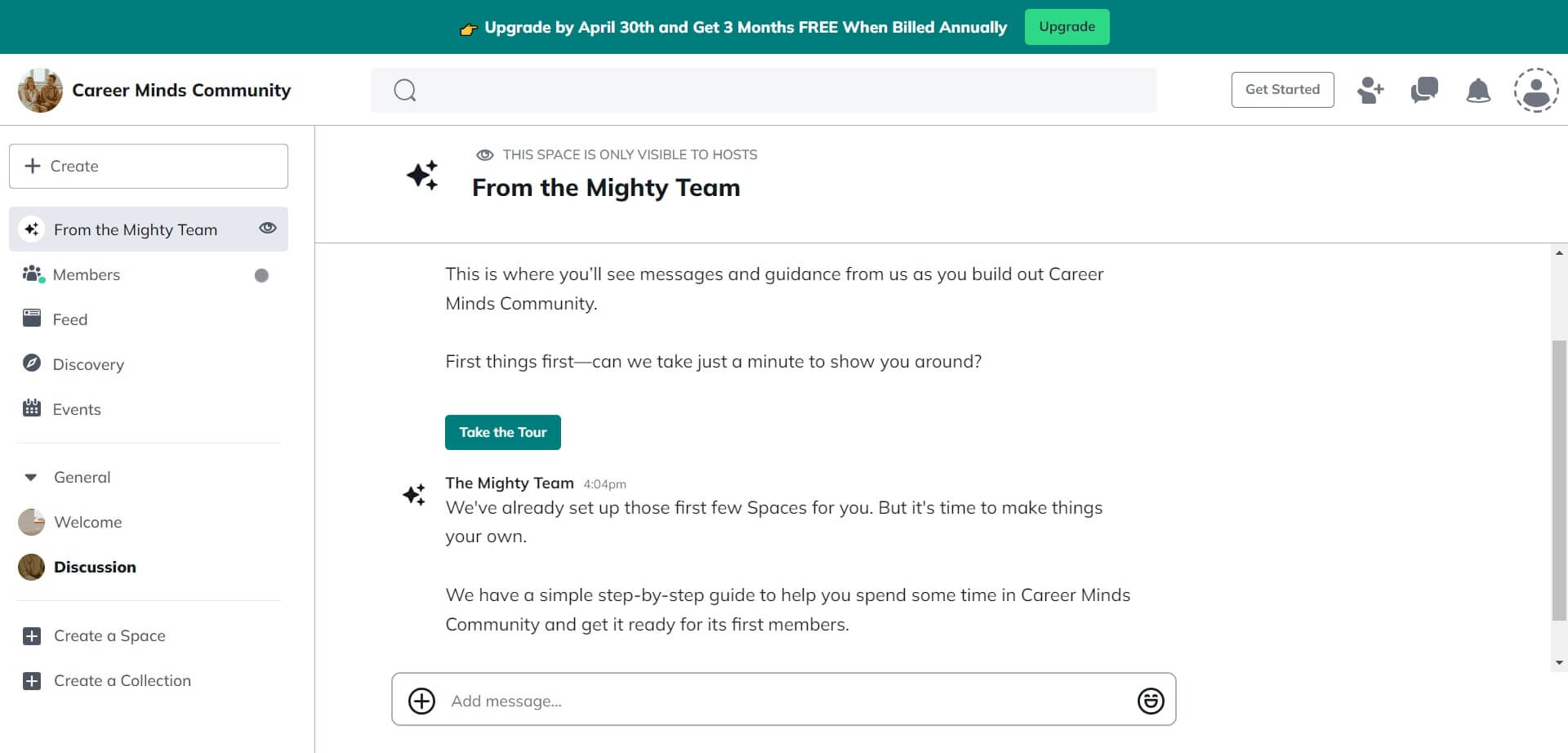
Mighty Networks is a cloud-membership site software renowned for its robust community-building capabilities. Widely regarded as one of the premier platforms for fostering online communities, it frequently complements the offerings of educational platforms like Thinkific, enriching their learning experiences with vibrant social engagement.
Mighty Networks offers a comprehensive suite of community, social, and discussion features. It has built-in analytics and its intuitive interface allows seamless member interaction via discussion forums, direct messaging, and customizable profiles. The platform provides great tools for content creation and organization, allowing you to curate rich multimedia resources and structured courses.
Some of its drawbacks, though, include a steep learning curve, especially when setting up and customizing community features. Mighty Networks also lacks some of the more advanced capabilities found in specialized learning management systems.
Pros
Pros
- Free trial (14 days)
- Community-rich features
- Built-in livestream
- Built-in analytics
- Discussion forums
- Direct messaging
- Mobile app
Cons
- Limited learning features
- Limitations on Livestream
- Limited integrations
- No email marketing
- Not many marketing & sales tools
How much does Mighty Networks cost?
Mighty Networks’ price starts at $49, but you will need the $119 plan to have online courses. You need to opt-in for the higher plans to receive additional features, mobile apps, white-label, branded apps, and more.
*Pricing information retrieved from Mighty Networks, April 2024.
See more alternatives to Mighty Networks.
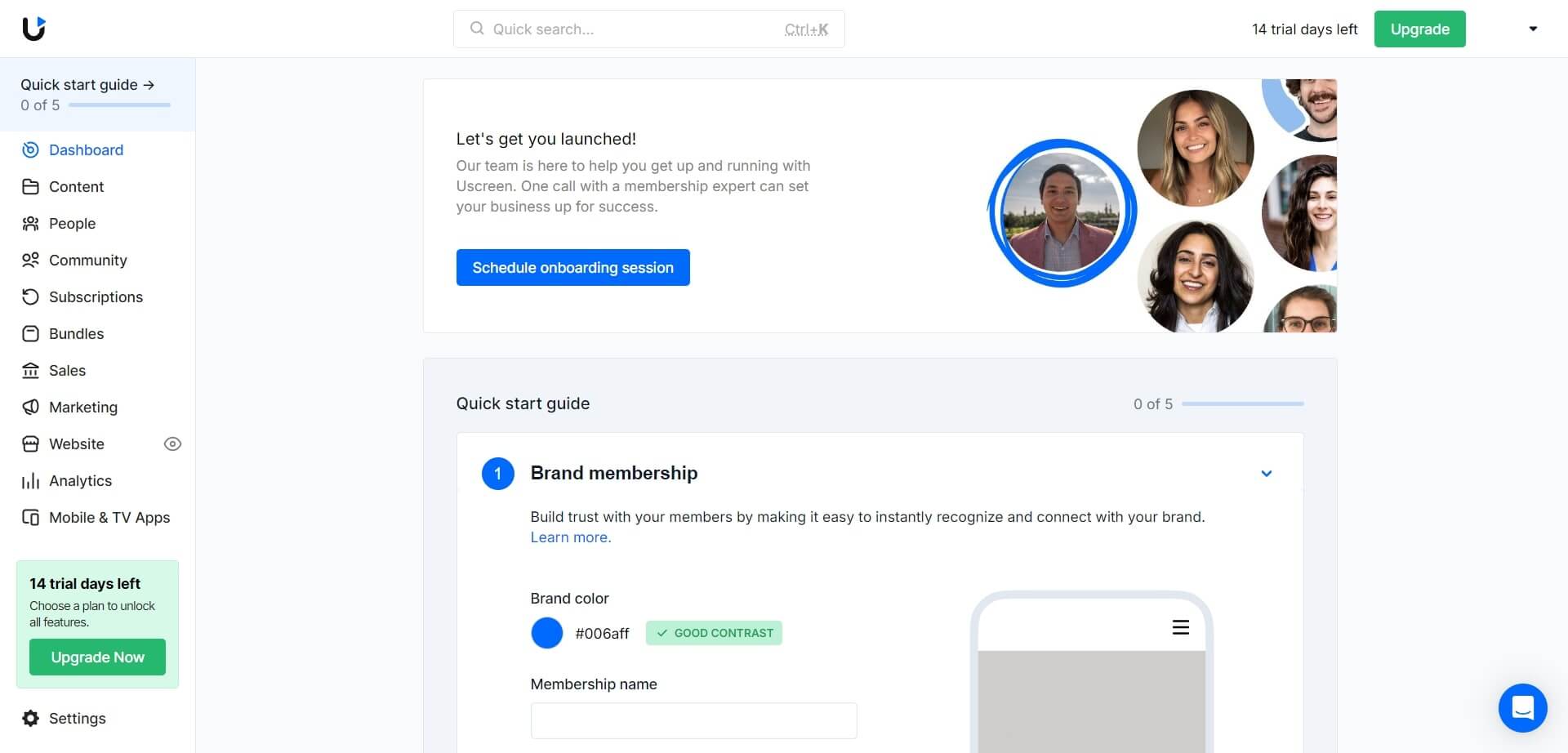
Uscreen is a primary video platform that provides a comprehensive suite of tools dedicated to content organization, monetization, and audience engagement. It excels in empowering creators to establish video-based subscriptions, streaming services, membership websites, and courses exclusively focused on video content. Its popularity among YouTubers and video creators is attributable to its robust features, including video hosting, monetization options, live streaming capabilities, and TV applications.
However, Uscreen may not be the optimal choice for educators and businesses seeking a complete package beyond video content, as its offerings are tailored primarily toward video-centric businesses and content creators. While it offers a range of features tailored specifically to video, it may lack the comprehensive features required for broader educational or business purposes. Despite this limitation, Uscreen remains a powerful tool for those looking to monetize and engage their audience effectively with their video content.
Pros
Pros
- Easy-to-use platform
- Beautiful themes
- Branded OTT apps
- Live streaming
- Mobile apps
Cons
- Expensive pricing with add-ons
- Difficult to cancel a trial or subscription
- Learning tools and features are not available
- Not a very user-friendly interface
- Limited customization options
- Poor support
How much does Uscreen cost?
Uscreen starts at a higher monthly price than most course platforms—$199—and charges its plans based on uploaded and live-streaming video hours and admin users. The higher plans—Pro and Plus—offer premium features like the mobile app, community with up to 5 channels, dedicated support, custom branding, and TV apps.
*Pricing information retrieved from Uscreen, April 2024.
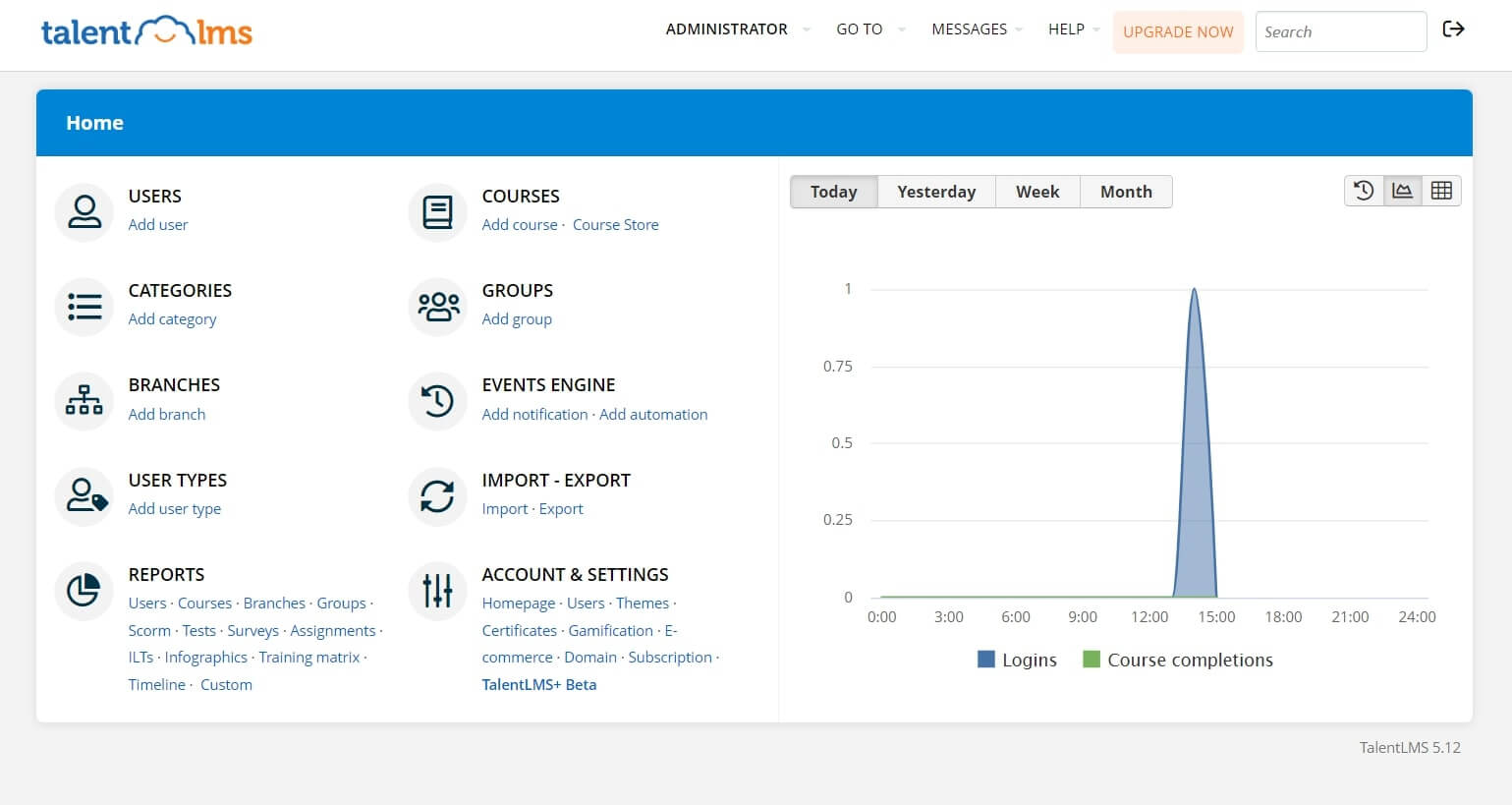
TalentLMS is a cloud-based learning management system that caters to corporate training and educational needs. It offers a robust toolset and features for content creation, course administration, assessments, and reporting. The platform’s biggest advantage is its simplicity of use, as it has a user-friendly interface and is mobile-compatible.
Compared to Thinkific, it offers fewer customization options but allows multiple content types and caters to a broader audience, including businesses, educational institutions, and enterprises. It also has great gamification capabilities, custom branding, and automation and integrates with several popular tools. In terms of reporting, the platform isn’t as powerful, which is unexpected, considering it mostly caters to businesses and enterprises with more diverse needs.
Pros
Pros
- User-friendly interface
- Supports multiple content types
- Off-the-shelf content
- Mobile app
- Rich gamification features
- Free plan
Cons
- Limited design customization
- Basic reporting tools
- Complicated course layout
- TalentLibrary can be expensive
How much does TalentLMS cost?
TalentLMS offers a limited “forever-free” plan for up to 5 users and 10 courses, with unlimited email support. Its paid plans have two pricing tiers: Standard and Active.
Standard plans:
Active plans:
*Pricing information retrieved from TalentLMS, April 2024.
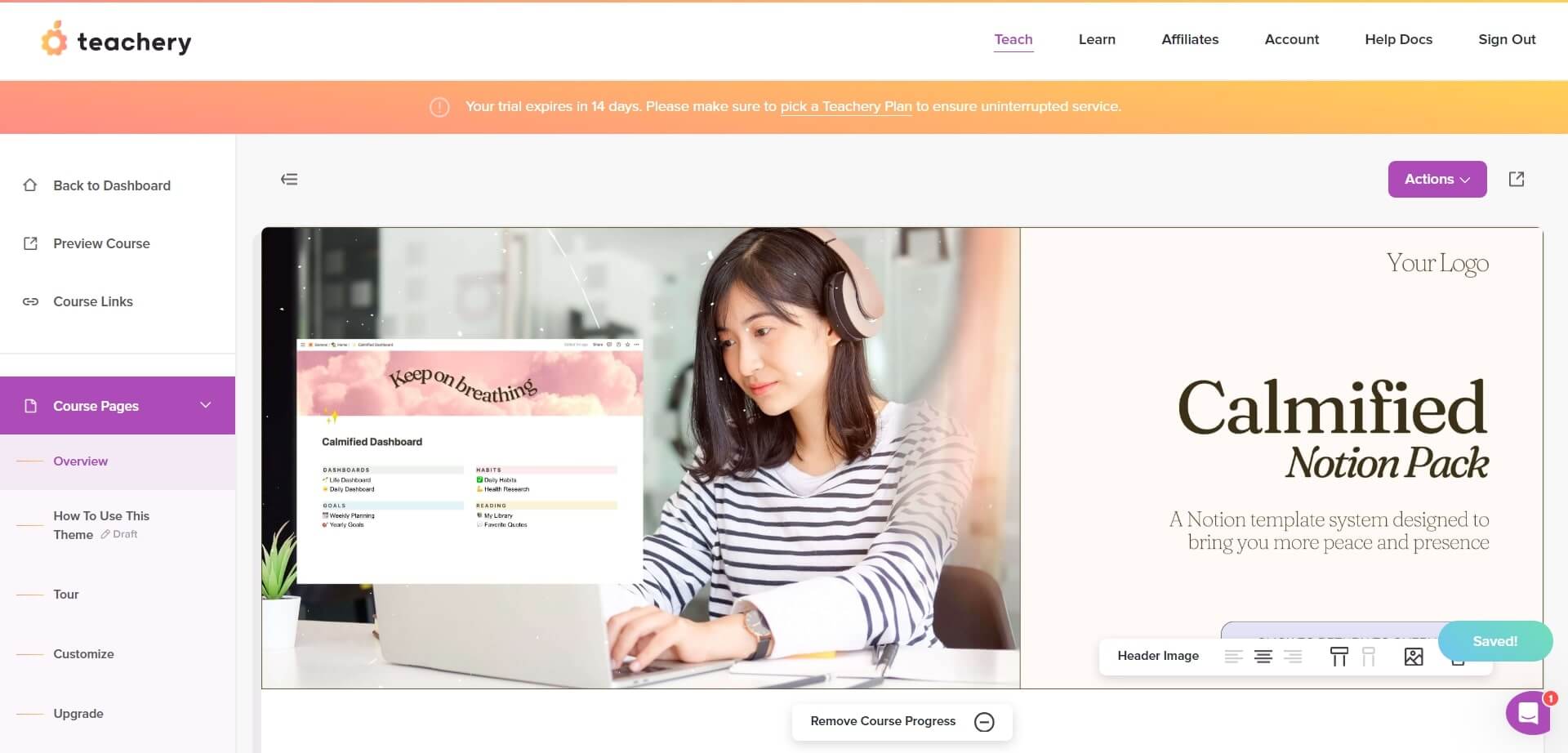
Teachery is a user-friendly online course platform emphasizing simplicity and ease of use. Geared toward individual course creators and small businesses, the platform offers essential tools for course creation, payment processing, and student engagement. Its minimalist approach allows educators to quickly set up and share their courses without the complexities of larger learning management systems.
As such, it’s a good choice if you want a simple course creation experience. Teachery has a clean, simple, and modern interface. It offers some customizable templates to aid the course creation process and allow users to get started right away. A few areas it lacks are advanced course creation capabilities, customization over branding and design, integrations, and email support.
Pros
Pros
- Simple pricing (no additional fees)
- Cost-effective
- Straightforward course creation
- Customizable templates
- Course Hubs and Memberships
- Course bundles
- Custom domain
- Unlimited courses
Cons
- Limited integrations
- Limited customization
- Limited support
- Basic payment processing
- Basic course creation tools
- Less suitable for advanced needs
How much does Teachery cost?
Teachery comes with a 14-day free trial and a straightforward pricing structure on a monthly and yearly basis.
*Pricing information retrieved from Teachery, April 2024.
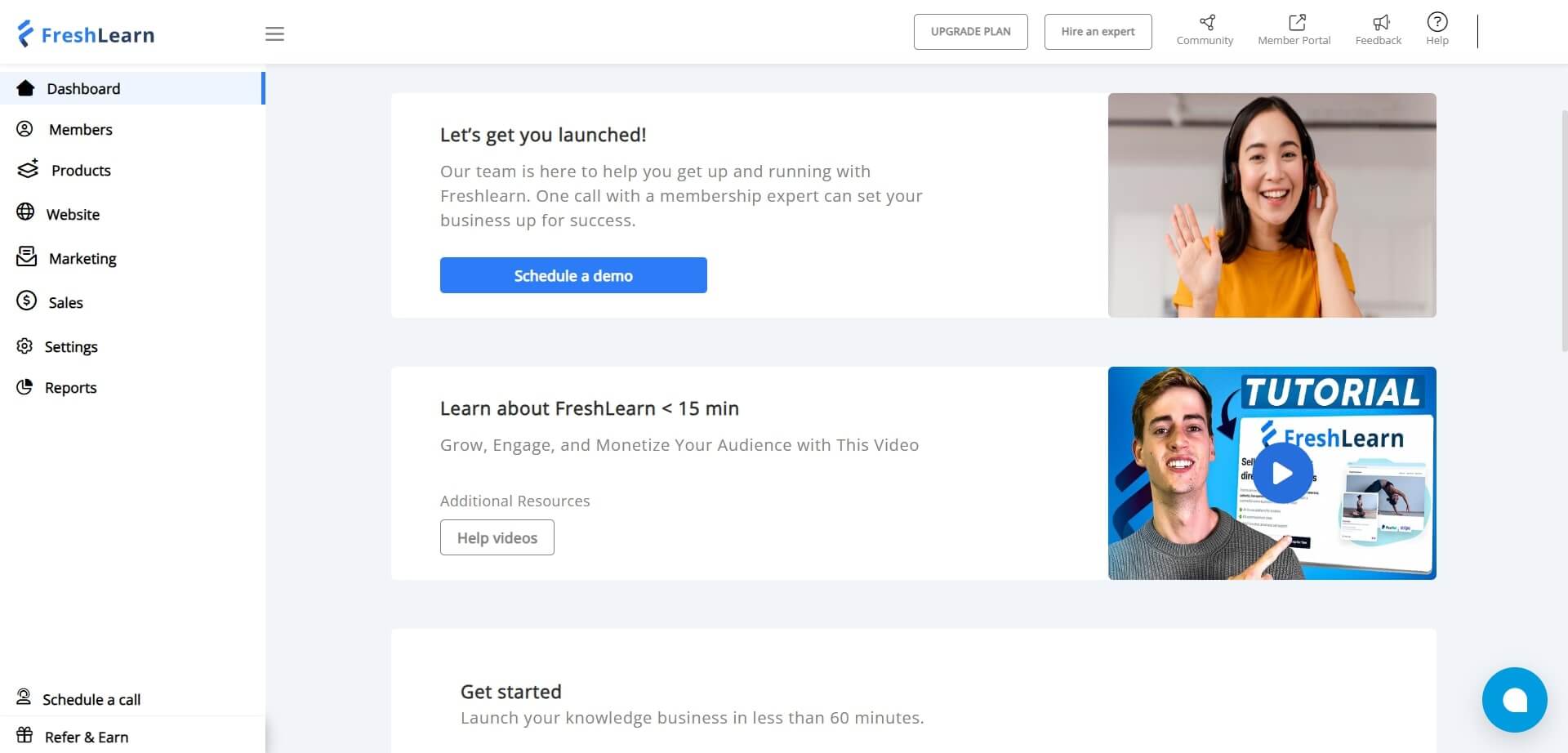
FreshLearn is a modern learning management system designed to deliver streamlined and intuitive learning experiences. Through its user-centric design, FreshLearn supports course creation, multimedia integration, assessments, and progress tracking. It aims to simplify creating and managing courses, enabling educators to focus on content delivery, building cohorts, masterclasses, digital downloads, communities, and more.
The platform comes with a range of course-building features, website-building functionality, and sales and marketing tools. However, like any other course platform, it has limitations. It only has a mobile app for Android devices and no one-click sales funnels.
Pros
Pros
- Drag-and-drop builder
- Clean and user-friendly design
- Good customer support
- Gamification and question banks
- Integrations
- Mobile app
- Drip content
- No transaction fees
- Completion certificates
- Sales & checkout pages
- Email campaigns
- Communities
Cons
- No 1-click sales funnels or pipelines
- Doesn’t support SCORM
- No priority support
- Only up to 3 admins
- No code editor or popups
How much does FreshLearn cost?
FreshLearn comes with a free trial and has the following pricing plans:
*Pricing information retrieved from FreshLearn, April 2024.
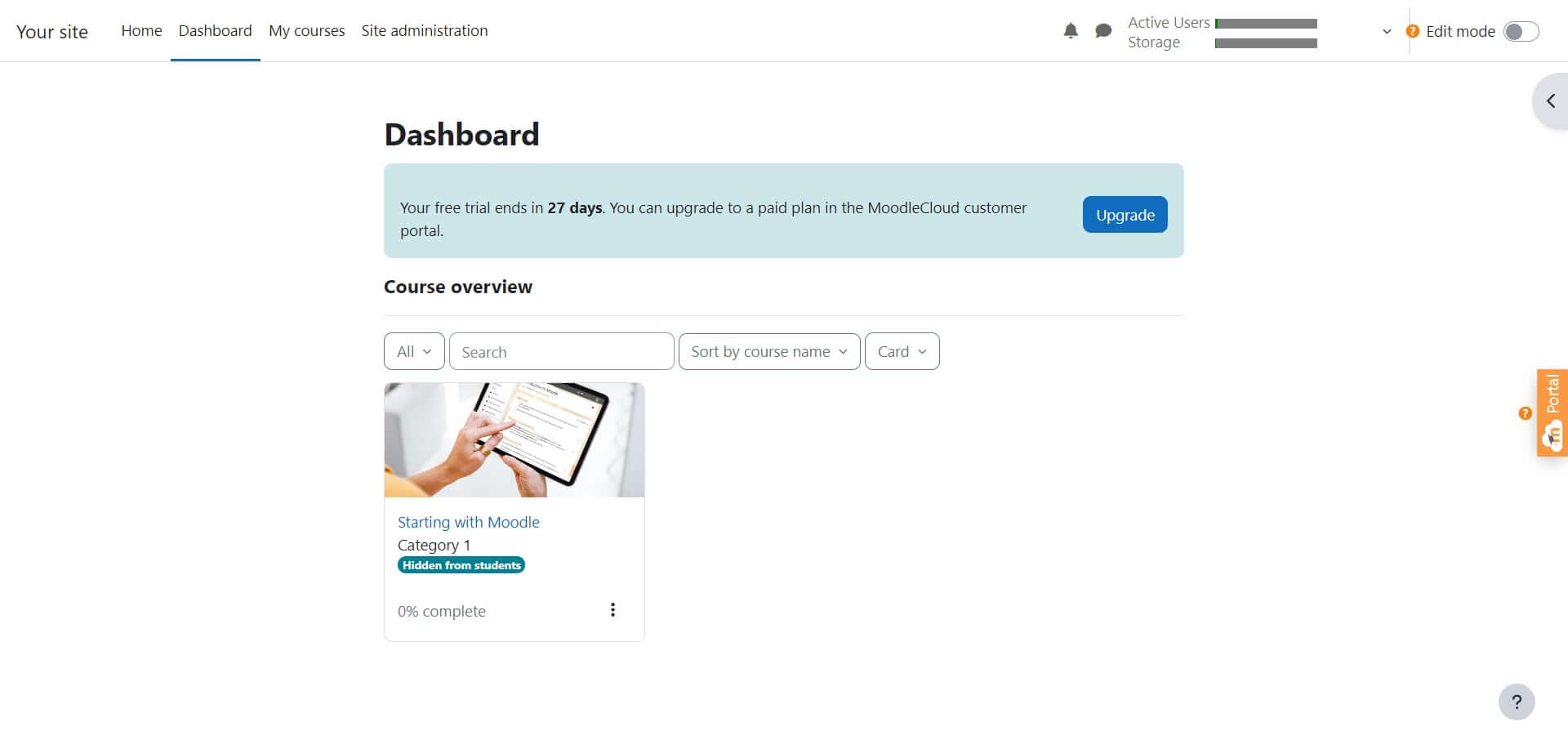
MoodleLMS is an open-source learning management system that enables educators to build personalized online learning experiences. It offers a range of features for course creation, content management, assessments, and communication tools. MoodleLMS’s flexibility allows users to tailor courses to specific teaching methods and provides a platform for asynchronous learning, making it popular among educational institutions and businesses.
The platform supports multiple types of content, including documents, multimedia, quizzes, assignments, and more. It’s well-suited for creating complex learning paths and assessments. In contrast to Thinkific and other platforms in this list, however, it is not as easy to use, and users may need additional time and technical expertise to take advantage of its full potential.
Pros
Pros
- Open-source platform
- Extensive customization
- Active community and support forums
- Code Editor and assessments
- Highly scalable (suitable for large organizations)
- Integrations
- White labeling
Cons
- A steep learning curve for beginners
- Customization may require plugins and technical expertise
- Additional costs associated with hosting, maintenance, customization, and support
How much does MoodleLMS cost?
Moodle comes with a free trial and offers 2 pricing options. There are the standard plans and the premium solutions.
Standard plans are yearly plans, and prices vary depending on your needs (number of users and storage). For premium solutions, you get custom pricing.
*Pricing information retrieved from Moodle, April 2024.
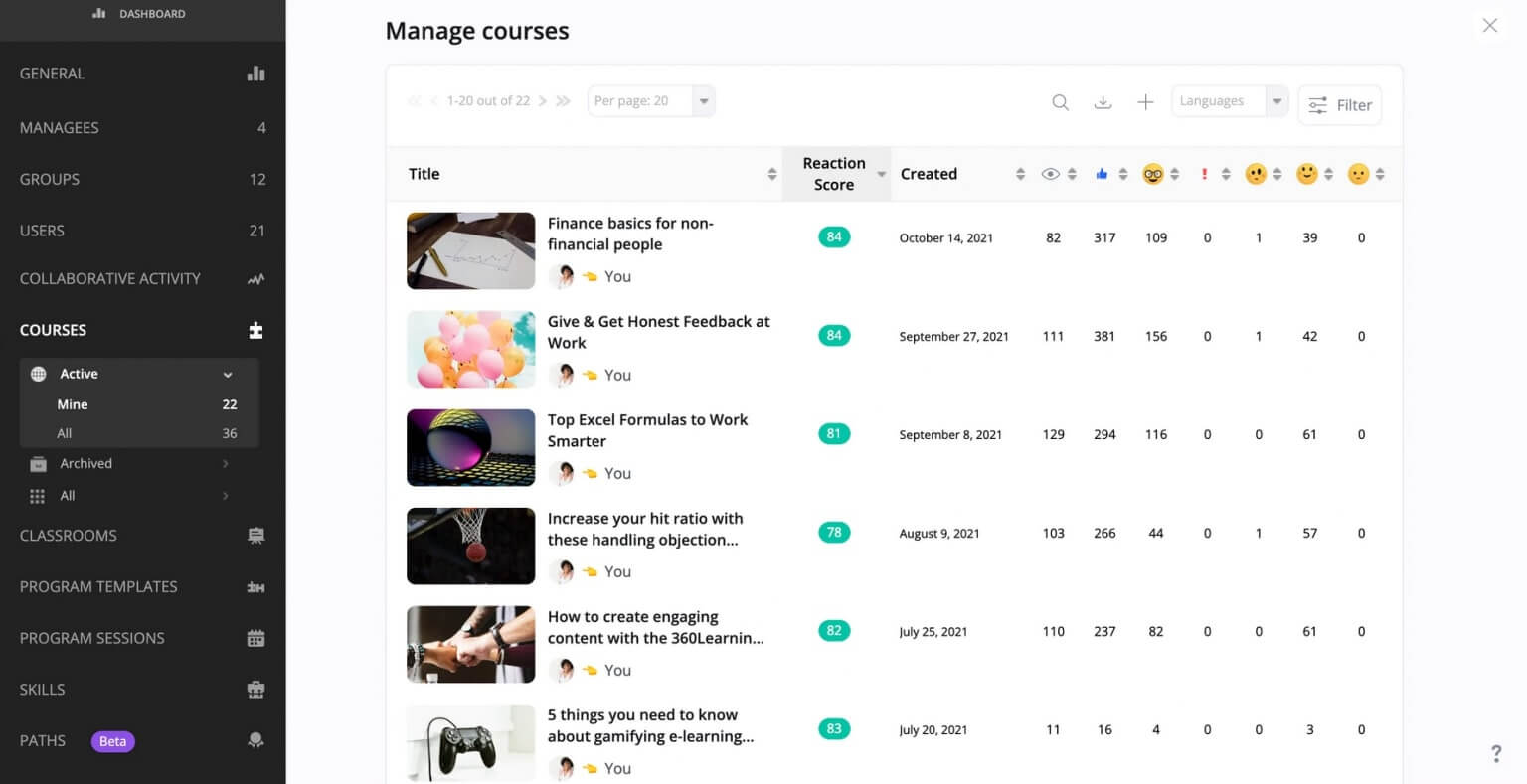
360 Learning is a collaborative learning platform designed to facilitate employee training and development through an engaging and interactive environment. With a strong emphasis on social learning, 360Learning empowers organizations to create, share, and track various learning materials, including courses, videos, and assessments. Its intuitive interface and built-in communication tools encourage seamless knowledge sharing and foster a dynamic learning community.
It also comes with powerful content management and course creation features that prioritize collaborative learning and social engagement. Despite these strong features, its customization ability is limited, its reporting functionality can be difficult to use, and its pricing is on the higher end.
Pros
Pros
- User-friendly interface
- Off-the-shelf content
- Collaborative learning tools
- Discussion forums and peer reviews
- Real-time feedback
- Robust analytics and reporting
- Automations
- Mobile app
Cons
- Limited customization features
- Complex reporting functionality
- Limited e-commerce tools
- Limited integration options
- Slow customer support
- More expensive compared to other solutions
How much does 360Learning cost?
360Learning comes with two pricing plans – A team and a Business plan.
*Pricing information retrieved from 360Learning, April 2024.
💡Ready to find the perfect platform for your online courses? Discover how to choose the right elearning solution in this FREE expert webinar.
Choosing a great Thinkific alternative to host your website and online courses depends on your individual or business needs. Are you looking for a video hosting platform, a learning platform, an LMS, or a platform to build your membership sites or community?
As you can see, there are many options out there, ranging from standalone platforms, all-in-one platforms like LearnWorlds, WordPress plugins like LearnDash, and even marketplaces like Udemy. Each platform has its advantages and disadvantages, and you will need to see which one best fits your requirements.
In this article, we have presented the top Thinkific competitors, and the verdict persists – compared to Thinkific, LearnWorlds is the best platform. Our platform is feature-packed and is the best option if you want to create awesome learning experiences, sell courses, and build a beautiful, customizable website that fully represents your brand.
Get your 30-day free trial and start exploring LearnWorlds today!
Kajabi offers robust marketing tools but is more expensive than Thinkific. For those seeking a balance of features and affordability, LearnWorlds stands out as a top choice. While Kajabi excels in marketing, Thinkific offers flexibility in course design, and LearnWorlds wins over the learning experience. To determine the best platform for your needs, we recommend comparing LearnWorlds, Thinkific, and Kajabi.
Teachable is more suitable for first-time creators and coaches, while Thinkific is for trainers, SMEs, and course creators, the same as LearnWorlds. Teachable offers simpler courses and a simpler interface. Thinkific offers a bigger toolset and customization options, and LearnWorlds offers advanced features for course creation and engagement with added customization.
LearnWorlds is the best platform to create, market, and sell online courses. It offers robust course authoring tools, interactive video, SCORM-compliance, an AI Creator, and many marketing, sales, and landing page creation tools via a no-code Website Builder. With it, you can offer the best user experience to your learners.
Yes, Thinkific has a free plan to test the platform’s basic features.
What are the benefits of Thinkific?
Thinkific has the following advantages:
Thinkific is a course platform where you can host your courses on your website, keep all the earnings to yourself, and own the customer data (and emails). While Udemy is a marketplace that controls the data, takes a big chunk of the money you make, but requires no technical understanding to set up your courses.
Kyriaki is a Content Creator for the LearnWorlds team writing about marketing and e-learning, helping course creators on their journey to create, market, and sell their online courses. Equipped with a degree in Career Guidance, she has a strong background in education management and career success. In her free time, she gets crafty and musical.
Nick Malekos is a Senior Digital Marketer in LearnWorlds. He is a results based and well-rounded Digital Marketer with years of experience in the education industry, writer and digital literacy trainer.

